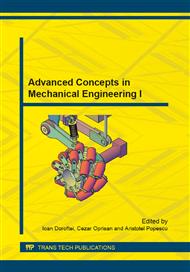p.183
p.189
p.195
p.201
p.207
p.213
p.219
p.225
p.233
An Analytical Solution for Three-Dimensional Elliptical Elastic-Plastic Rolling Contact
Abstract:
An analytical three-dimensional elastic-plastic over-rolling solution is used to evaluate the plastic strains and residual stresses. Central to this plastic contact formulation is the incremental approach to deal with non-linear material behavior. The Prandtl-Reuss constitutive equations in conjunction with Huber-Mises-Hencky yield criterion and Ramberg-Osgood strain-hardening relationships are applied to describe the plastic behavior of common hardened bearing steel. The model was extended to include the tangential force in the rolling direction, assumed to be proportional to the hertzian contact pressure. Comparisons of three-dimensional pure rolling and rolling/sliding contact results were provided to elucidate the differences in residual stresses and residual profiles in case of kinematic and work-hardening materials.
Info:
Periodical:
Pages:
207-212
Citation:
Online since:
October 2014
Authors:
Price:
Сopyright:
© 2014 Trans Tech Publications Ltd. All Rights Reserved
Share:
Citation:


